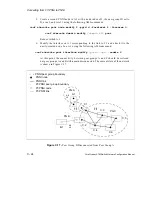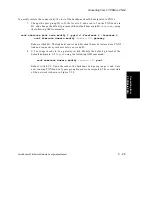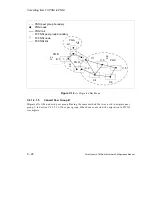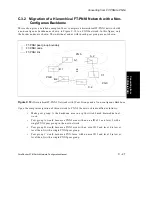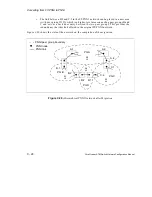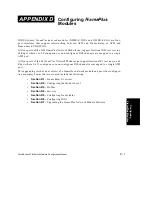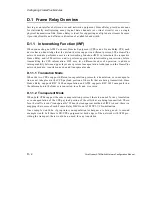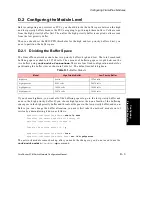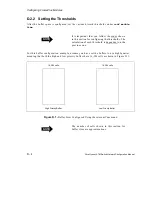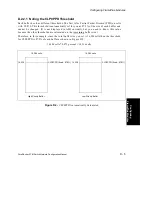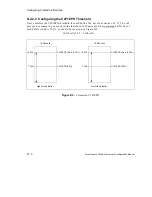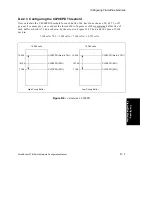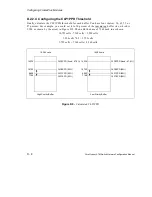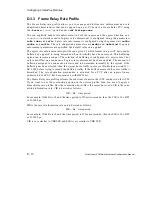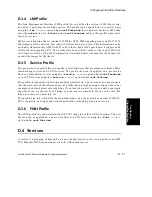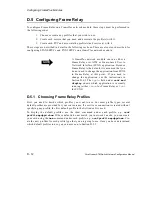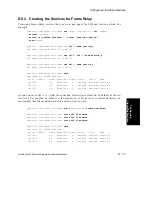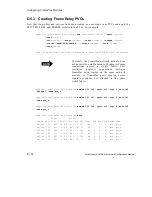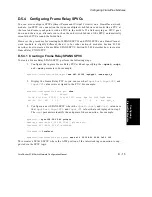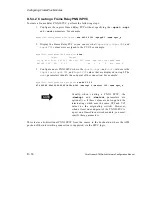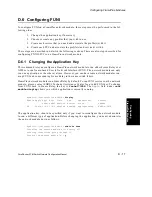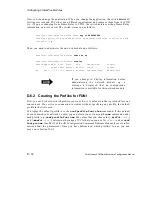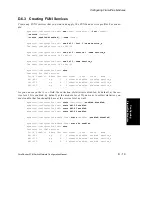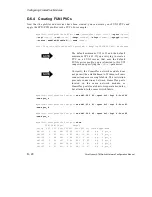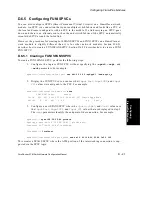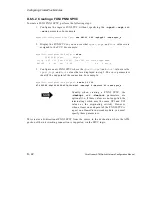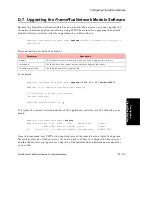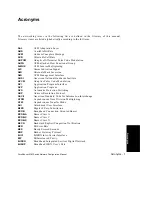
D - 10
ForeRunner
ATM Switch Network Configuration Manual
Configuring FramePlus Modules
D.3.3 Frame Relay Rate Profile
The Frame Relay rate profile allows you to manage and define rate enforcement and rate
adaptation characteristics that can be applied on a per-VC basis to a Frame Relay PVC using
the
-frrate
<index>
option under
conf
fratm
pvc
new
.
You can explicitly enable rate enforcement in both the ingress and the egress direction on a
FramePlus
network module. Ingress rate enforcement is configured using the parameters
inBc
,
inBe
, and
inCir
. Egress rate enforcement is configured using the parameters
outBc
,
outBe
, and
outCir
. The rate adaptation parameters are
minBc
and
cmPeriod
. If no rate
enforcement parameters are specified, the default values are applied.
The egress rate enforcement also provides an option by which frames on a per-VC basis can be
buffered as opposed to being discarded when thresholds have been crossed. This buffering
option can increase goodput. The selection of buffering is configured at a service level, but
only takes effect on a connection if egress rate enforcement has been enabled. The amount of
buffering assigned to a connection is finite and is determined internally by the system. If the
buffering has been selected, then the system holds traffic in excess of Bc+Be for a period Tc (=
Bc/CIR), before trying to resend the buffered traffic. If the buffer becomes full, excess traffic is
discarded. The rate adaptation mechanism is activated for a PVC after an ingress frame,
addressed to the PVC, has been received with BECN set.
The Frame Relay rate profile performs the exact same function that UPC contracts do for ATM.
If you want to use the overbooking option in the service profile, then you need to apply a
Frame Relay rate profile. Bc is the committed burst, Be is the excess burst, and CIR is the com-
mitted information rate. CIR is derived as follows:
CIR = Bc / time period
For example, if the Bc is 10 and the time period is 125 microseconds, then the CIR is 10 x 8192
or 81,920 bps.
EIR is the excess information rate and is derived as follows:
EIR = Be / time period
For example, if the Be is 10 and the time period is 125 microseconds, then the EIR is 10 x 8192
or 81,920 bps.
CIR is very similar to VBR SCR and EIR is very similar to VBR PCR.
Summary of Contents for forerunner series
Page 6: ......
Page 16: ...TOC 10 ForeRunner ATM Switch Network Configuration Manual Table of Contents ...
Page 20: ...LOF 4 ForeRunner ATM Switch Network Configuration Manual List of Figures ...
Page 22: ...LOT 2 ForeRunner ATM Switch Network Configuration Manual List of Tables ...
Page 30: ...viii ForeRunner ATM Switch Network Configuration Manual Preface ...
Page 144: ...3 58 ForeRunner ATM Switch Network Configuration Manual Configuring an Emulated LAN ...
Page 180: ...6 12 ForeRunner ATM Switch Network Configuration Manual ATM Forum PNNI ...
Page 220: ...9 6 ForeRunner ATM Switch Network Configuration Manual Configuring Timing ...
Page 300: ...D 24 ForeRunner ATM Switch Network Configuration Manual Configuring FramePlus Modules ...
Page 308: ...Acronyms 8 ForeRunner ATM Switch Network Configuration Manual Acronyms ...
Page 346: ...Glossary 38 ForeRunner ATM Switch Network Configuration Manual Glossary ...
Page 352: ...Index 6 ForeRunner ATM Switch Network Configuration Manual Index ...

